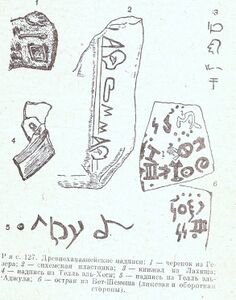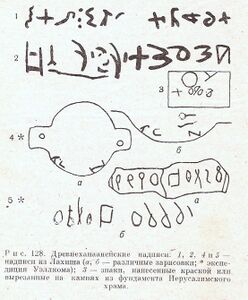الأبجدية الكنعانية الأولية
(تم التحويل من Proto-Canaanite alphabet)
| الأبجدية الكنعانية الأولية | |
|---|---|
| النوع | آخر |
| اللغات | السامية الشمالية الغربية ؟ اللغة الفلستينية |
| المخترع | كنعان |
| الاختراع | ليس قبل القرن 16 ق.م. |
| الفترة الزمنية | القرن 16 ق.م. - القرن 11 ق.م. |
| الحالة | لم تُفك كل رموزها بعد |
النظم الوالدة | الأبجدية السينائية الأولية
|
النظم الشقيقة | الفينيقية الأوغاريتية |
Proto-Canaanite is the name given to
- (a) the Proto-Sinaitic script when found in Canaan, dating to about the 17th century BC and later.[1]
- (b) a hypothetical ancestor of the Phoenician script before some cut-off date, typically 1050 BCE, with an undefined affinity to Proto-Sinaitic.[2] No extant "Phoenician" inscription is older than 1000 BCE.[3] The Phoenician, Hebrew, and other Canaanite dialects were largely indistinguishable before that time.[4]
صور
- A sherd from Gezer found in 1929, a stone plate from Shechem found in 1937 and an inscription on a dagger from Lachish found in 1934 , however, the inscription was discovered and published only in 1937 . The inscriptions of this group date back to the 16th century BC. e.
- A shard from Tell el-Khesi , discovered in 1891 , and a pot found in 1932 from Tell el-'Ajjul . Also, the ostraca from Beit Shemesh , found in 1930, can be attributed to this or to the third group . The inscriptions from this group date from the 14th century BC. e.
- Several inscriptions from Lachish: an inscription on a jar found in 1934 , an inscription on a bowl discovered a year later , an inscription on the lid of an incense burner found in 1936 , and "Bowl from Lachish No. 2" found in 1934. These inscriptions date from the second half of the 13th century BC. e. This group also includes a gold ring from Megiddo , which the archaeologist P. L. O. Guy, who found it, dates back to 1300-1200. BC e. The third group may also include signs on the foundation stones of the Jerusalem Temple.
- آثار عليها كتابة كنعانية أولية
اكتشافات لاحقة
In 1964, the Dutch archaeologist H. J. Franken discovered during the excavations of Deir Alla (English) rus. several plates. Since the signs were outwardly different from the Phoenician and belonged to an earlier period, and Philistine ceramics were found along with them, he erroneously identified the writing as a type of Minoan [4] . Later, several mutually exclusive attempts were made to interpret inscriptions in Semitic languages [5] [6] [7] .
In 1977 in Izbet Tsarta (fr.)rus. a sherd was found containing not only a few lines of text in Proto-Canaanite writing, but also a complete alphabetical repertoire of characters, going in the same order as the Phoenician alphabet [8] .
المراجع
- ^ Woodard, Roger (2008), The Ancient Languages of Syria-Palestine and Arabia, p. 4, ISBN 9781139469340, https://books.google.com/books?id=vTrT-bZyuPcC&pg=PA4.
- ^ Coulmas, Florian (1996). The Blackwell Encyclopedia of Writing Systems. Oxford: Blackwell. ISBN 0-631-21481-X.
- ^ Hoffman, Joel M. (2004). In the beginning : a short history of the Hebrew language. New York, NY [u.a.]: New York Univ. Press. p. 23. ISBN 978-0-8147-3654-8. Retrieved 23 May 2017.
By 1000 B.C.E., however, we see Phoenician writings [..]
- ^ Naveh, Joseph (1987), "Proto-Canaanite, Archaic Greek, and the Script of the Aramaic Text on the Tell Fakhariyah Statue", in Miller, Ancient Israelite Religion.
وصلات خارجية
This article contains content from Wikimedia licensed under CC BY-SA 4.0. Please comply with the license terms.

